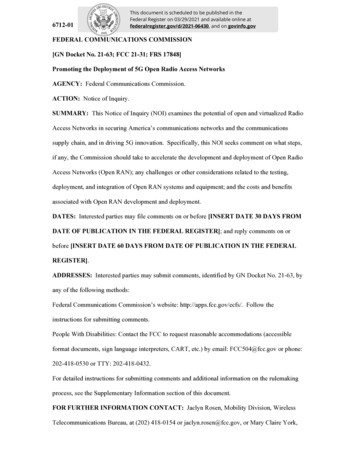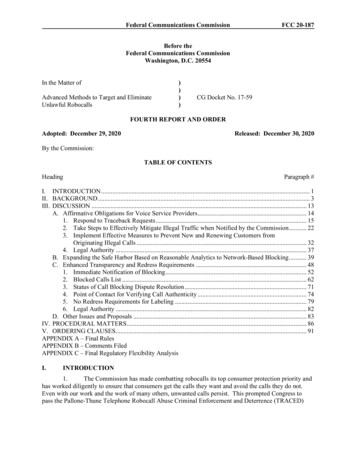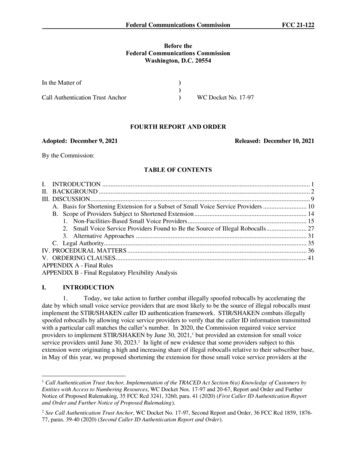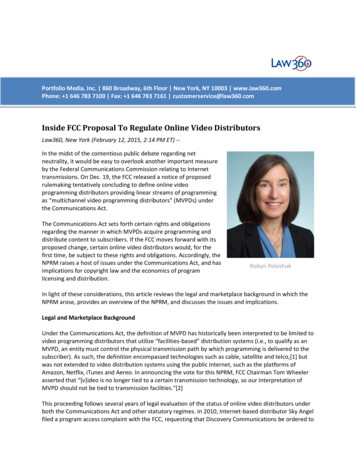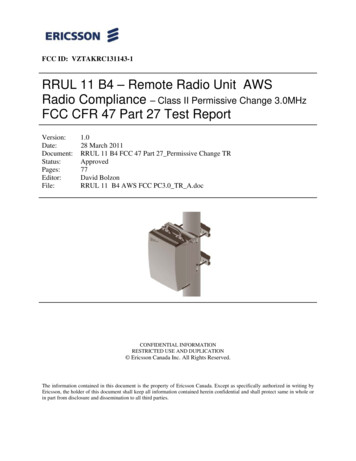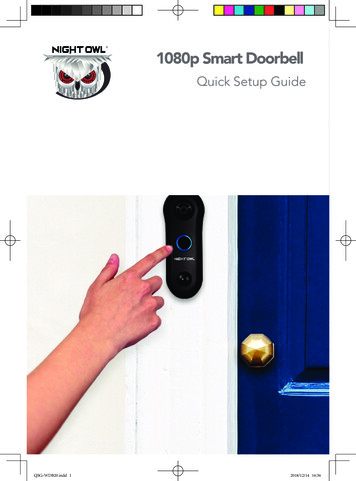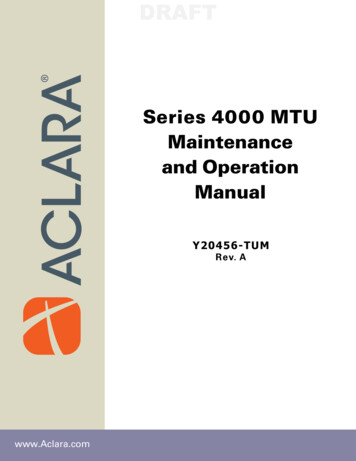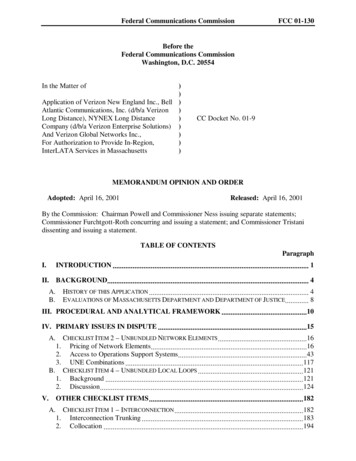
Transcription
Federal Communications CommissionFCC 01-130Before theFederal Communications CommissionWashington, D.C. 20554In the Matter of))Application of Verizon New England Inc., Bell )Atlantic Communications, Inc. (d/b/a Verizon )Long Distance), NYNEX Long Distance)Company (d/b/a Verizon Enterprise Solutions) )And Verizon Global Networks Inc.,)For Authorization to Provide In-Region,)InterLATA Services in Massachusetts)CC Docket No. 01-9MEMORANDUM OPINION AND ORDERAdopted: April 16, 2001Released: April 16, 2001By the Commission: Chairman Powell and Commissioner Ness issuing separate statements;Commissioner Furchtgott-Roth concurring and issuing a statement; and Commissioner Tristanidissenting and issuing a statement.TABLE OF CONTENTSParagraphI.INTRODUCTION . 1II. BACKGROUND. 4A. HISTORY OF THIS APPLICATION . 4B. EVALUATIONS OF MASSACHUSETTS DEPARTMENT AND DEPARTMENT OF JUSTICE. 8III. PROCEDURAL AND ANALYTICAL FRAMEWORK .10IV. PRIMARY ISSUES IN DISPUTE .15A.CHECKLIST ITEM 2 – UNBUNDLED NETWORK ELEMENTS .16Pricing of Network Elements.16Access to Operations Support Systems.43UNE Combinations .117HECKLISTB. CITEM 4 – UNBUNDLED LOCAL LOOPS .1211. Background .1212. Discussion.1241.2.3.V.OTHER CHECKLIST ITEMS .182A.CHECKLIST ITEM 1 – INTERCONNECTION .1821. Interconnection Trunking .1832. Collocation .194
Federal Communications CommissionFCC 01-1303.4.Technically Feasible Points of Interconnection .197Pricing of Interconnection .198B. CHECKLIST ITEM 3 – POLES, DUCTS, CONDUITS AND RIGHTS OF WAY .2051. Background .2052. Discussion.206C. CHECKLIST ITEM 5 – UNBUNDLED LOCAL TRANSPORT .207D. CHECKLIST ITEM 13 – RECIPROCAL COMPENSATION .213E. CHECKLIST ITEM 14 – RESALE .217F. REMAINING CHECKLIST ITEMS (6-12).222VI. COMPLIANCE WITH SECTION 271(C)(1)(A) .223A.B.BACKGROUND .223DISCUSSION .224VII.SECTION 272 COMPLIANCE .226A.B.BACKGROUND .226DISCUSSION .2271. Unchallenged Sections .2282. Challenged Sections .229VIII. PUBLIC INTEREST ANALYSIS .232COMPETITION IN LOCAL EXCHANGE AND LONG DISTANCE MARKETS .234ASSURANCE OF FUTURE COMPLIANCE .2361. Performance Assurance Plan .2372. Key Elements of the Performance Assurance Plan .240C. OTHER ISSUES .249A.B.IX. SECTION 271(D)(6) ENFORCEMENT AUTHORITY .250X.CONCLUSION .253XI. ORDERING CLAUSES .254APPENDIX A – LIST OF COMMENTERSAPPENDIX B – STATUTORY REQUIREMENTS – CHECKLIST ITEMS 6-12I.INTRODUCTION1.On January 16, 2001, Verizon New England Inc., Bell Atlantic Communications,Inc. (d/b/a Verizon Long Distance), NYNEX Long Distance Company (d/b/a Verizon EnterpriseSolutions), and Verizon Global Networks Inc. (Verizon) filed this application pursuant to section2
Federal Communications CommissionFCC 01-130271 of the Communications Act of 1934, as amended,1 for authority to provide in-region,interLATA service originating in the state of Massachusetts.2 We grant this application in thisOrder based on our conclusion that Verizon has taken the statutorily required steps to open itslocal exchange markets to competition in Massachusetts.2.In approving this application, we wish to recognize the hard work of theMassachusetts Department of Telecommunications and Energy (Massachusetts Department) inlaying the foundation for approval of this application. The Massachusetts Department hasconducted critically important proceedings concerning Verizon’s section 271 compliance open toparticipation by all interested parties. The Massachusetts Department and Verizon also providedfor third-party testing of Verizon’s operations support systems (OSS) offering. In addition, theMassachusetts Department adopted a broad range of performance measures and standards and aPerformance Assurance Plan designed to create a financial incentive for post-entry compliancewith section 271. State proceedings such as these serve a vitally important role in the overallsection 271 approval process.3.We also commend Verizon for all of the work that it has undertaken to open itslocal exchange market to competition in Massachusetts. For example, Verizon states thatcompetitive local exchange carriers (competitive LECs) serve more than 513,000 lines on afacilities basis in Massachusetts, with Verizon providing more than 333,000 interconnectiontrunks and 1,700 collocation nodes to competitive LECs. Verizon also states that it providesmore than 93,000 unbundled local loops, including more than 69,000 stand-alone unbundled localloops and more than 23,000 unbundled loops provided as part of an unbundled network elementplatform (UNE-P). There is also an active resale market in Massachusetts. Verizon states that itprovides more than 268,000 resold local exchange lines, including 238,000 business lines and30,000 residential lines. These results bear out the fact that Verizon has made extensive efforts toopen its local markets in compliance with the requirements of the Act.3II.BACKGROUNDA.History of this Application4.In the 1996 amendments to the Communications Act, Congress required that theBell Operating Companies (BOCs) demonstrate compliance with certain market openingrequirements contained in section 271 of the Act prior to entering the in-region, interLATAmarket. Congress also provided for Commission review of BOC applications to provide such1In 1996, Congress amended the Communications Act of 1934 to foster the development of local exchangecompetition, among other things. The Telecommunications Act of 1996, Pub. L. No. 104-104, 110 Stat. 56 (1996).We refer to the Communications Act of 1934, as amended by the Telecommunications Act of 1996, as theCommunications Act or the Act.2Supplemental Filing of Verizon New England, CC Docket No. 01-9 (filed Jan. 16, 2001) (VerizonMassachusetts II Application).3See id. Attach. A.3
Federal Communications CommissionFCC 01-130services in consultation with the affected state and the Attorney General. The Commission hassummarized the applicable statutory framework in a number of prior orders and need not repeatthis material here.45.On May 24, 1999, Verizon filed a draft section 271 application with theMassachusetts Department.5 The Massachusetts Department conducted a sixteen-monthinvestigation of Verizon’s compliance with section 271. These proceedings were open to fullparticipation by all interested parties. This process included: a comprehensive third-party test ofVerizon’s OSS; numerous technical sessions with the Department’s staff, Verizon and manycompetitive LECs; a series of public hearings and oral arguments; and hundreds of informationrequests.6.In August of 1999, the Massachusetts Department contracted with KPMGconsulting, L.L.C. to perform a third-party test of Verizon’s OSS performance. In January 2000,the Massachusetts Department adopted the performance metrics developed in the New Yorkcarrier-to-carrier proceeding as the metrics to be used and replicated by KPMG in evaluatingVerizon’s performance in Massachusetts.6 On September 7, 2000, KPMG issued its final report,which found that Verizon satisfied 800 of 804 test points relating to its review of Verizon’s OSS.77.Verizon filed its initial application for section 271 authority for the state ofMassachusetts (the Massachusetts I Application) on September 22, 2000, 8 but later chose to4See, e.g., Joint Application by SBC Communications Inc., Southwestern Bell Tel. Co., and Southwestern BellCommunications Services, Inc., d/b/a Southwestern Bell Long Distance for Provision of In-Region, InterLATAServices in Kansas and Oklahoma, Memorandum Opinion and Order, FCC 01-29, CC Docket No. 00-217, paras.7-10 (rel. Jan. 22, 2001) (SWBT Kansas/Oklahoma Order); Application by SBC Communications Inc.,Southwestern Bell Tel. Co., and Southwestern Bell Communications Services, Inc. d/b/a Southwestern Bell LongDistance Pursuant to Section 271 of the Telecommunications Act of 1996 To Provide In-Region, InterLATAServices in Texas, Memorandum Opinion and Order, 15 FCC Rcd 18354, 18359-61, paras. 8-11 (2000) (SWBTTexas Order); Application by Bell Atlantic New York for Authorization Under Section 271 of the CommunicationsAct To Provide In-Region, InterLATA Service in the State of New York, Memorandum Opinion and Order, 15 FCCRcd 3953, 3961-63, paras. 17-20 (1999) (Bell Atlantic New York Order).5See Verizon Massachusetts I Application App. B, Vol. 1a-aa, Tab 2 (Massachusetts DTE, D.T.E. 99-271,Inquiry by the Department of Telecommunications and Energy pursuant to Section 271 of the TelecommunicationsAct of 1996 into the Compliance Filing of New England Telephone and Telegraph Company d/b/a Bell AtlanticMassachusetts as part of its application to the Federal Communications Commission for entry into the in-regioninterLATA (long distance) telephone market).6See Verizon Massachusetts I Application App. B, Vol. 24, Tab 282 (Massachusetts DTE, D.P.U. 99-271,Evaluation of Bell Atlantic-Massachusetts Operations Support Systems: Final Attachment A to 11/19/99 LetterOrder on Final Master Test Plan (Jan. 14, 2000)).7See generally Verizon Massachusetts I Application App. I, Vol. 1a-b (KPMG Final Report).8Application by Verizon New England for Authorization to Provide In-Region, InterLATA Services inMassachusetts, CC Docket No. 00-176 (filed Sept. 22, 2000) (Verizon Massachusetts I Application).4
Federal Communications CommissionFCC 01-130withdraw it.9 Verizon filed another application for Massachusetts (the Massachusetts IIApplication) on January 16, 2001.10 The Massachusetts II Application incorporates the materialin the original application by reference to demonstrate compliance with most of the section 271requirements. It also provides additional information concerning Verizon’s provision of DSLcapable local loops, the availability of loop make-up information and line sharing. In addition,competitive LECs now have access to Verizon’s carrier specific performance data.11B.Evaluations of Massachusetts Department and Department of Justice8.The Massachusetts Department supports Verizon’s application to provide inregion, interLATA long distance service originating in Massachusetts. Specifically, it concludedthat Verizon had met the requirements of section 271, and urged the Commission to approveVerizon’s in-region, interLATA entry in both its October 16, 2000 evaluation of theMassachusetts I Application,12 and its February 6, 2001 evaluation of the Massachusetts IIApplication.139.The Department of Justice filed its evaluation of Verizon’s Massachusetts IApplication on October 27, 2000.14 It recommended that the Commission not approve theapplication until Verizon had demonstrated that it provides nondiscriminatory access to DSLcapable loops and established suitable performance measures with unambiguous benchmarks forDSL-capable loops.15 The Department of Justice submitted an evaluation of Verizon’s9See Letter from Michael E. Glover, Senior Vice President & Deputy General Counsel, Verizon, to MagalieRoman Salas, Secretary, Federal Communications Commission, CC Docket No. 00-176 (filed Dec. 18, 2000).10Verizon Massachusetts II Application.11The availability of this information plays a critical role in the ability of competitive LECs to participate in thesection 271 application review process.12Evaluation of the Massachusetts Department of Telecommunications and Energy, CC Docket No. 00-176(filed October 16, 2000) (Massachusetts Department Massachusetts I Comments). On November 3, 2000, theMassachusetts Department filed its reply (Massachusetts Department Massachusetts I Reply).13Evaluation of the Massachusetts Department of Telecommunications and Energy, CC Docket No. 01-9 (filedFebruary 6, 2001) (Massachusetts Department Massachusetts II Comments). On February 28, 2001, theMassachusetts Department filed its second reply (Massachusetts Department Massachusetts II Reply).14Evaluation of the United States Department of Justice, CC Docket No. 00-176 (filed October 27, 2000)(Department of Justice Massachusetts I Evaluation).15See Department of Justice Massachusetts I Evaluation at 2. The Department of Justice found that, “althoughVerizon has satisfied this standard in most respects, important issues remain inadequately addressed.” Id. It notedthat the principal issue on which Verizon had failed to develop an adequate record was its provision of DSLcapable loops. See id. The Department concluded that Verizon had not yet demonstrated that it providesnondiscriminatory access to DSL-capable loops, including line sharing, or that adequate performance mechanismswere in place to deter backsliding. See id. at 24. The Department of Justice recommended that we not permitVerizon to offer interLATA services in Massachusetts until Verizon demonstrated that it has resolved theseshortcomings. See id. at 3.5
Federal Communications CommissionFCC 01-130Massachusetts II Application on February 21, 2001.16 It recognized that a “number of changeshave taken place” since it filed its evaluation of the Massachusetts I Application andacknowledged that the second Verizon application “shows improvement in some aspects ofVerizon’s performance in providing access to DSL loops,” although it highlighted severalremaining disputed issues related to the provision of nondiscriminatory access to DSL-capableloops.17 The Department of Justice stated that it was unable to resolve those remaining issuesbased on the record on file at the time of its evaluation.18 As a result, it stated that it could notfind at that stage of the proceeding that Verizon had adequately demonstrated its ability toprovide nondiscriminatory access to DSL-capable loops.19 Recognizing that its evaluationreflected only the evidence in the record at the time of its evaluation, however, the Department ofJustice urged the Commission to consider the full record -- as it developed in reply comments andex parte submissions -- in its final determination.20III.PROCEDURAL AND ANALYTICAL FRAMEWORK10.To determine whether a BOC applicant has met the prerequisites for entry into thelong distance market, we evaluate its compliance with the competitive checklist, as developed inour local competition rules and orders in effect at the time the application was filed. Despite thecomprehensiveness of our rules, there will inevitably be, in any section 271 proceeding, disputesover an incumbent LEC’s precise obligations to its competitors that our rules have not addressedand that do not involve per se violations of self-executing requirements of the Act. As theCommission has explained in prior orders, the section 271 process simply could not function asCongress intended if we resolved all such disputes as a precondition to granting a section 271application.21 In prior orders, the Commission has explained the procedural rules it has developed16Evaluation of the United States Department of Justice, CC Docket No. 00-176 (filed February 21, 2001)(Department of Justice Massachusetts II Evaluation).17Department of Justice Massachusetts II Evaluation at 2-3. For example, the Department of Justice noted,among other things, that: (1) Verizon and the competing carriers modified, and the Massachusetts Departmentadopted, the carrier-to-carrier measures for DSL-capable loop performance and created a set of measures for linesharing; (2) Verizon submitted to the Massachusetts Department changes to its performance assurance plan,proposing to add additional DSL-capable loop and line sharing measurements and make DSL a separate mode ofentry; (3) Verizon’s separate data affiliate, Verizon Advanced Data, Inc. (VADI), became fully operational inMassachusetts; (4) Verizon agreed to proceed with the development and deployment of a mechanism to providecompeting carriers with electronic access to loop make-up information; and (5) Verizon conducted re-inspectionsof line sharing related collocation work, enabled some line sharing orders to flow through its systems withoutmanual intervention, and established a wholesale service center dedicated to DSL-capable loops and line sharing.See id.18See Department of Justice Massachusetts II Evaluation at 3, 14; see also id. at 7-14 (describing issues indispute).19See id. at 14.20See id. at 15 & n.61.21See SWBT Kansas/Oklahoma Order at para. 19; see also American Tel. & Tel. Co. v. FCC, 220 F.3d 607, 631(D.C. Cir. 2000).6
Federal Communications CommissionFCC 01-130to facilitate the review process.22 Here we describe how we consider the evidence of compliancethat Verizon has presented to us in this proceeding.11.As part of our determination that a BOC has satisfied the requirements of section271, we consider whether the BOC has fully implemented the competitive checklist in subsection(c)(2)(B). The BOC at all times bears the burden of proof of compliance with section 271, even ifno party challenges its compliance with a particular requirement. In demonstrating itscompliance, a BOC must show that it has a concrete and specific legal obligation to furnish theitem upon request pursuant to state-approved interconnection agreements that set forth prices andother terms and conditions for each checklist item, and that it is currently furnishing, or is ready tofurnish, the checklist items in quantities that competitors may reasonably demand and at anacceptable level of quality.23 In particular, the BOC must demonstrate that it is offeringinterconnection and access to network elements on a nondiscriminatory basis.24 PreviousCommission orders addressing section 271 applications have elaborated on this statutorystandard.25 First, for those functions the BOC provides to competing carriers that are analogousto the functions a BOC provides to itself in connection with its own retail service offerings, theBOC must provide access to competing carriers in “substantially the same time and manner” as itprovides to itself.26 For those functions that have no retail analogue, the BOC must demonstratethat the access it provides to competing carriers would offer an efficient carrier a “meaningfulopportunity to compete.”2712.In past orders, the Commission has found that the most probative evidence ofnondiscriminatory access to interconnection and UNEs is actual commercial usage, and“[p]erformance measures are an especially effective means of providing us with evidence of thequality and timeliness of the access provided by a BOC to requesting carriers.”28 We expect that,in its prima facie case in the initial application, a BOC relying on performance data will:22See, e.g., SWBT Kansas/Oklahoma Order at paras. 21-27; SWBT Texas Order, 15 FCC Rcd at 18370-73,paras. 34-42; Bell Atlantic New York Order, 15 FCC Rcd at 3968-71, paras. 32-42.23See Bell Atlantic New York Order, 15 FCC Rcd at 3973-74, para. 52.24See 47 U.S.C. § 271(c)(2)(B)(i), (ii).25See SWBT Kansas/Oklahoma Order at paras. 28-29; Bell Atlantic New York Order, 15 FCC Rcd at 3971-72,paras. 44-46.26SWBT Texas Order, 15 FCC Rcd at 18373, para. 44; Bell Atlantic New York Order, 15 FCC Rcd at 3971, para.44.27Bell Atlantic New York Order, 15 FCC Rcd at 3971, para. 44; Application of Ameritech Michigan Pursuant toSection 271 of the Communications Act of 1934, as amended, To Provide In-Region, InterLATA Services inMichigan, Memorandum Opinion and Order, 12 FCC Rcd 20543, 20618-19, para. 141 (1997) (AmeritechMichigan Order).28Bell Atlantic New York Order, 15 FCC Rcd at 3969, para. 53.7
Federal Communications CommissionFCC 01-130a) provide sufficient performance data to support its contention that the statutoryrequirements are satisfied;b) identify the facial disparities between the applicant’s performance for itself andits performance for competitors;c) explain why those facial disparities are anomalous, caused by forces beyond theapplicant’s control (e.g., competing carrier-caused errors), or have nomeaningful adverse impact on a competing carrier’s ability to obtain and servecustomers; andd) provide the underlying data, analysis, and methodologies necessary to enablethe Commission and commenters meaningfully to evaluate and contest thevalidity of the applicant’s explanations for performance disparities, including,for example, carrier specific carrier-to-carrier performance data.13.The Massachusetts Department has adopted the performance metrics andstandards established by the New York Commission. Under this framework, for functions withretail analogues, Verizon provides a figure indicating the degree of statistical significance for anydifferences in performance for competitors as compared to performance for its retail operations.For functions with a performance benchmark, Verizon provides data on its performance, whichare then compared to the benchmark. The Commission has explained in prior orders that parityand benchmark standards established by state commissions do not represent absolute maximum orminimum levels of performance necessary to satisfy the competitive checklist. Rather, where, ashere, these standards are developed through open proceedings with input from both theincumbent and competing carriers, these standards can represent informed and reliable attempts toobjectively approximate whether competing carriers are being served by the incumbent insubstantially the same time and manner, or in a way that provides them a meaningful opportunityto compete.29 Thus, to the extent there is no statistically significant difference between Verizon’sprovision of service to competing carriers and its own retail customers, we generally need notlook any further. Likewise, if Verizon’s provision of service to competing carriers satisfies theperformance benchmark, our analysis is usually done. Otherwise, we will examine the evidencefurther to make a determination whether the statutory nondiscrimination requirements are met.30Thus, we will examine the explanations that Verizon and others provide about whether these dataaccurately depict the quality of Verizon’s performance. We also may examine how many monthsa variation in performance has existed and what the recent trend has been. We may find thatstatistically significant differences exist, but conclude that such differences have little or nocompetitive significance in the marketplace. In such cases, we may conclude that the differencesare not meaningful in terms of statutory compliance. Ultimately, the determination of whether aBOC’s performance meets the statutory requirements necessarily is a contextual decision based onthe totality of the circumstances and information before us.29See SWBT Kansas/Oklahoma Order at para. 31; SWBT Texas Order, 15 FCC Rcd at 18377, para. 55 & n.102.30See Bell Atlantic New York Order, 15 FCC Rcd at 3970, para. 59.8
Federal Communications CommissionFCC 01-13014.In this application, we examine performance data as reported in carrier-to-carrierreports reflecting service in the most recent full months before filing (i.e., from Septemberthrough December 2000). We also examine Verizon’s January performance data in a fewinstances for the limited purpose of confirming the acceptable performance or a trend ofimprovement shown in earlier months’ data. Verizon has asserted that some of these data areaffected by a workers’ strike that took place in August 2000. We address the relevance of thestrike and Verizon’s explanations of its impact on the data below in our discussions of specificaspects of Verizon’s performance.IV.PRIMARY ISSUES IN DISPUTE15.In this Order, we assess all aspects of compliance with section 271, but we focusprimarily on the most controversial checklist compliance issues as the Commission did in therecent SWBT Kansas/Oklahoma Order.31 First, we address checklist item 2, which encompassesaccess to unbundled network elements, including issues related to OSS and combinations ofnetwork elements as well as pricing. We then discuss checklist item 4, access to unbundled localloops. The remaining checklist requirements are then discussed briefly because commentingparties did not comment as extensively, or at all, on them, and our own review of the record leadsus to conclude that Verizon has satisfied these requirements. We then address Verizon’s showingof compliance with the requirements of Track A in Massachusetts. Finally, we discuss issuesconcerning compliance with section 272 and the public interest requirement, and our section271(d)(6) enforcement authority. It is our hope that this approach will serve to focus attention onthe section 271 requirements commenting parties address most extensively, while streamlining thediscussion of the other less or noncontroversial requirements.A.Checklist Item 2 – Unbundled Network Elements1.Pricing of Network Elementsa.Background16.Checklist item 2 of section 271 states that a BOC must provide“[n]ondiscriminatory access to network elements in accordance with the requirements of sections251(c)(3) and 252(d)(1)” of the Act.32 Section 251(c)(3) requires LECs to provide“nondiscriminatory access to network elements on an unbundled basis at any technically feasiblepoint on rates, terms, and conditions that are just, reasonable, and nondiscriminatory. . . .”33Section 252(d)(1) requires that a state commission’s determination of the just and reasonablerates for network elements shall be based on the cost of providing the network elements, shall benondiscriminatory, and may include a reasonable profit.34 Pursuant to this statutory mandate, the31See SWBT Kansas/Oklahoma Order at para. 39.3247 U.S.C. § 271(B)(ii).33Id. § 251(c)(3).34Id. § 252(d)(1).9
Federal Communications CommissionFCC 01-130Commission has determined that prices for unbundled network elements (UNEs) must be basedon the total element long run incremental cost (TELRIC) of providing those elements.3517.Although the United States Court of Appeals for the Eighth Circuit stayed theCommission’s pricing rules in 1996,36 the Supreme Court restored the Commission’s pricingauthority on January 25, 1999, and remanded to the Eighth Circuit for consideration of the meritsof the challenged rules.37 On remand from the Supreme Court, the Eighth Circuit concluded thatwhile TELRIC is an acceptable method for determining costs, certain specific rules containedwithin the Commission’s pricing rules were contrary to Congressional intent.38 The Eighth Circuithas stayed the issuance of its mandate pending review by the Supreme Court.39 Accordingly, theCommission’s rules remain in effect for purposes of this application.18.The Massachusetts Department established its prices for UNEs in an extensiveproceeding beginning when several carriers requested arbitration of interconnection agreementswith Verizon in July 1996. 40 In Phase 4 of its Consolidated Arbitrations proceeding, theMassac
4 See, e.g., Joint Application by SBC Communications Inc., Southwestern Bell Tel. Co., and Southwestern Bell Communications Services, Inc., d/b/a Southwestern Bell Long Distance for Provision of In-Region, InterLATA Services in Kansas and Oklahoma, Memorandum Opinion and Order, FCC 01-29, CC Docket No. 00-217, paras.
